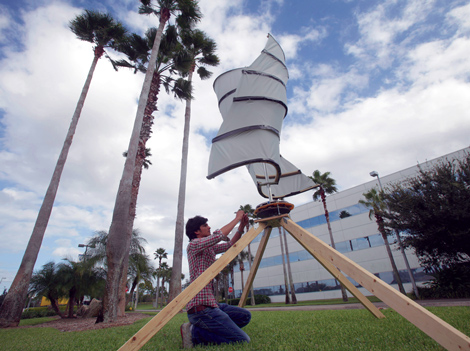Student Inventors: Manu Sharma

Manu Sharma and his innovative wind turbine
Ever dreamed of becoming an entrepreneur? If so, you’re in good company – over half of U.S. millennials (ages 18 to 34) say they want to start a business or already have done so, according to a recent survey from the Kaufmann Foundation. Even more exciting is the fact that nowadays, starting a business does not necessitate leaving school, as more and more universities are striving to accommodate entrepreneurial students.
In this new eGFI blog series, we bring you four inspiring stories of undergraduate engineering students who have successfully patented their original ideas, teamed up with classmates and professors to launch businesses, and navigated the startup world, all while keeping up with their coursework.
So step aside, Bill Gates – the days of dropout turned entrepreneur may be numbered.
Suvival of the Cleverest: Manu Sharma and Nuovo Wind
Browsing in an antique store on vacation two years ago, Embry-Riddle Aeronautical University senior Manu Sharma chanced upon a display of spiraling front-porch adornments known as wind twisters. Inspired, he thought: Why not make a wind turbine shaped like this? Sharma explained the idea to his honors-program professor, who encouraged him to seek university funding. That initial $1,000 grant spurred Sharma’s zest for entrepreneurship — and a start-up to develop and distribute his innovative power generator. Launched in early 2011, Nuovo Wind now has three classmates plus a faculty member on board, private investors, and a potential first customer: the Tanzanian government.
Manu Sharma’s trajectory from Embry-Riddle aerospace engineering major to postmodern wind-turbine designer – and head of a fledgling firm with $50,000 in venture capital – was anything but straightforward. It began with an entrepreneurial professor who encouraged him to develop his spark of an idea using a $1,000 school research grant.

A conceptual image of Sharma’s turbine (via Nuovo Wind)
To come up with a turbine that was both maximally efficient and inexpensive to make, Sharma employed a Darwin-like theory called evolutionary design optimization. The method involves generating a large number of potential designs on computer software and then using special algorithms to select the most “fit.” Using an open-source CAD program and developing his own evolutionary algorithms, Sharma ran through hundreds of designs, selecting the most efficient ones to “mate” — combine specific traits of two designs, like genetics — and produce even more fit “offspring.” He pursued his project fervently, doing most of his work outside of class and sometimes gathering advice from professors. “If I had free time between classes, I would grab a laptop and work on my code,” he says. Once he had perfected a small-scale model, Sharma applied for and won a second university research grant – for $7,500 – to fund a prototype.
Sharma’s wind-turbine design wasn’t the only thing that evolved. He also had to learn how to pitch his idea to potential investors and develop a sensible business plan. He gained this experience by “pretty much applying to all the clean-tech competitions I could find,” he says. Though he failed to win any, Sharma gained valuable experience presenting his invention to potential backers. More crucially, he learned that developing countries offered the best target market for his low-cost turbines, which can generate the same amount of electricity for one quarter the price of a traditional $10,000 wind turbine.
Here’s a video from Nuovo Wind that explains their turbine concept:
In early 2011, Sharma, now a fourth-year student, officially launched Nuovo Wind to make and distribute the turbines. Soon afterward, he was admitted to the prestigious Kairos Society, a nonprofit dedicated to providing the most talented young entrepreneurs with opportunities to network with global industry leaders. The experience further stoked Sharma’s passion for entrepreneurship, and his enthusiasm spread: Three classmates, also Embry-Riddle seniors, as well as his electrical and computer engineering professor, Brian Butka, signed on to the start-up. Now, in addition to private investors, the Tanzanian government has expressed interest in Nuovo Wind’s innovative turbines.
In many ways, Sharma followed the traditional, self-taught path many students have taken over the years. But now, thanks to the recent crop of entrepreneurship-focused curriculum options, more budding engineers are innovating inside as well as outside the classroom.
See our follow-up posts in this series for more stories of student innovators.
Filed under: Computer, e-News, Electrical, Mechanical
Tags: Computer, Electrical, Energy, Green Technology, Mechanical, Meet More Students, Student Inventors








